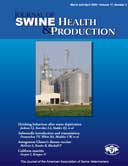Abstract:

Autogenous sow vaccination for Glasser’s disease in weaner pigs in two large swine farm systems
Steven McOrist, BVSc, PhD; Ross Bowles, PhD; Pat Blackall, PhD
PDF version is available online.
We aimed to effectively vaccinate sows in two large farm systems suffering severe Glasser’s disease in their weaner pigs. System A or B supplied 4000 or 7000 weaned pigs weekly to their respective single-site nursery facilities. Suspect serosal lesions were cultured for Haemophilus parasuis, with serotyping and genotyping for tbpA and tbpB transferrin-binding genes. Most cultured H parasuis were either serotype 5 or 12 or nontypable. Specific tbpA and tbpB PCR products were further analyzed for restriction fragment length polymorphisms. This indicated that the dominant strains were genotypes bb and hg (Farm A), and aa, bb, and kf (Farm B). Selected dominant-strain cultures were expanded and formalin-killed for use as autogenous bacterins in sows 5 and 2 weeks prior to farrowing. Mortality and average daily weight gain in sheds housing progeny derived from vaccinated sows (mortality of 0.5% to 0.9% of total population) were lower than those in sheds housing nonvaccinated progeny (mortality of 1.4% to 2.1%). Mortality due to Glasser’s disease remained low 1 year after introduction of the vaccine. We concluded that tbp gene analysis is a useful additional tool for identification of dominant and potentially protective strains of Haemophilus parasuis.
Keywords: Haemophilus parasuis, Glasser’s disease, vaccination, tbp genotype
![]() Cite as: McOrist S, Bowles R, Blackall P. Autogenous sow vaccination for Glasser’s disease in weaner pigs in two large swine farm systems. J Swine Health Prod 2009;17(2):90-96.
Cite as: McOrist S, Bowles R, Blackall P. Autogenous sow vaccination for Glasser’s disease in weaner pigs in two large swine farm systems. J Swine Health Prod 2009;17(2):90-96.
Search the AASV web site for pages with similar keywords.
